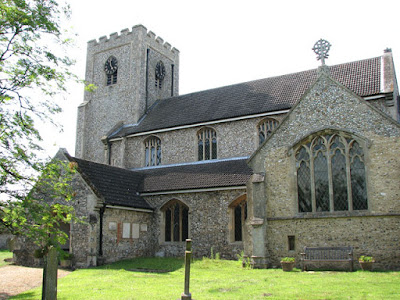
|
| St. Mary's Church in East Rudham |
Is it possible to encounter the ghost of a person still living? Is is possible to be in more than one place at the same time? These are just some of the questions that come to mind when examining the strange case of the Rev. Dr. Hugh Astley, the village vicar of East Rudham in England's Norfolk County during the early part of the 20th century.
The bizarre tale of Hugh Astley begins during the Christmas season of 1908. Astley decided to spend the holidays with his wife in Algeria, and left his vicarage in the hands of Rev. Robert Brock, whom he first met during a trip to London on December 9, 1908. Though they conversed for less than an hour, the two preachers immediately hit it off and Dr. Astley invited Rev. Brock to serve as his substitute over the holiday season.
On December 26, Rev. Brock received a letter from an English military chaplain stationed in Algiers by the name of Rev. Herbert Muriel. In his letter, the chaplain informed the substitute vicar that Dr. Astley and his wife were involved in a terrible train accident on December 16. Both had sustained serious injuries.
Later that same evening, as Brock was seated in the dining room of the vicarage the housekeeper, Mrs. Hartley, became startled and told him that Dr. Astley was waiting for him in the study.
"Looking through the glass window on the lawn I myself distinctly saw the figure of Dr. Astley, in clerical attire, standing against the wall which adjoins the dining room," stated Brock to a London newspaper in January of 1909. "I rubbed my eyes and looked again. I was not dreaming. The figure was not looking at me, but seemed to be plunged in thought.
"Mrs. Hartley had a candle in her hand and I told her to take it away. I still saw the figure most clearly. A housemaid who joined us could also see the figure."
Brock stated that the apparition of Dr. Astley appeared at around 4:45 in the afternoon and was visible for about ten minutes.
On December 29, Mrs. Hartley once again saw the vicar's apparition, this time in the garden.
According to Brock, the housekeeper went into the study and came out screaming, "Come quickly! Here it is again!" Brock raced into the study and looked out the window and could plainly see the apparition of Dr. Astley. Brock immediately sent a telegram to Algiers inquiring about the condition of the vicar and his wife, but was surprised to learn that they were both recovering well from their injuries.
However, Brock learned that the vicar, who had sustained a concussion in the accident, had twice lost consciousness for a brief period of time-- once on December 26, and once again on December 29. Brock believed that this might have had something to do with the timing of the apparitions.
"My own impression... was that Dr. Astley was dead," stated Rev. Brock. Now it would really appear that when we saw his figure outside the study window he was in a state of unconsciousness or delirium and in some way was able to project himself in living form to his home in England."
The ability to appear in two places at one time-- sometimes called "bilocation"-- has been documented for centuries and is often said to occur during times of extreme duress. One of the best known American cases of this phenomenon took place in Peabody, Massachusetts in 1915 when a young schoolgirl named Mary Renfrew narrowly escaped death during the St. John's Parochial School fire. While Mary was being pulled from the burning building in a state of unconsciousness by a fireman, numerous witnesses claim to have seen her a few blocks away at the exact same time.
Sources:
Hartford Republican, Jan. 22, 1909.